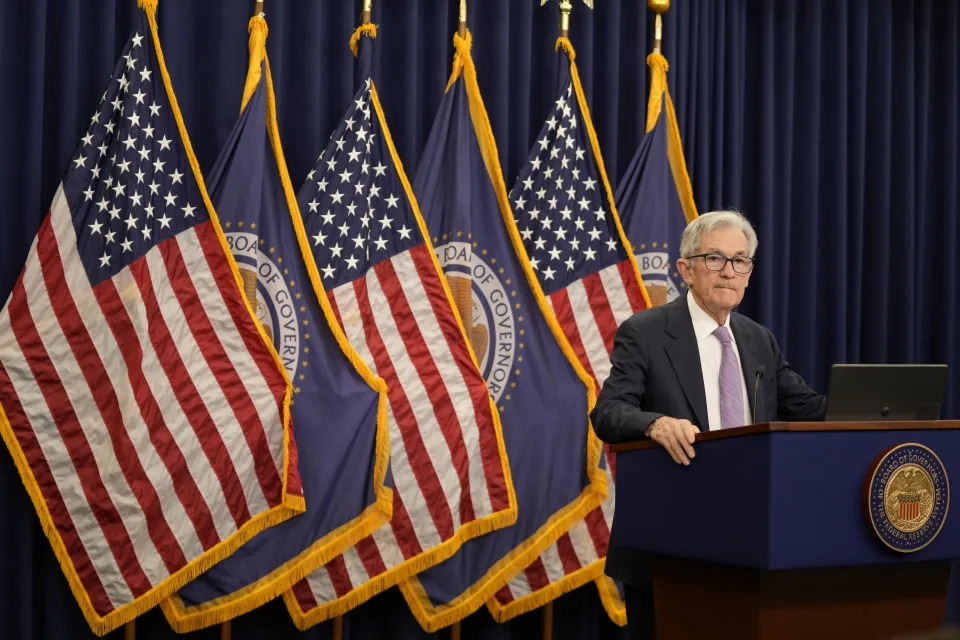Fed 'dot plot' shows central bank will cut interest rates 2 more times in 2025
The Federal Reserve lowered interest rates on Wednesday by 25 basis points to a range of 4.25%-4.5% at its final meeting of the year and signaled that it would slow down the pace of its cuts.
Along with its policy announcement, the Fed released updated economic forecasts in its Summary of Economic Projections (SEP), including its " dot plot ," which maps out policymakers' expectations for where interest rates could be headed in the future.
Read more: What the Fed rate cut means for bank accounts, CDs, loans, and credit cards
Fed officials see the fed funds rate falling to 3.9% in 2025, higher than the Fed's previous September projection of 3.4%. Outside of September's jumbo 50 basis point cut, the Fed has moved in 25 basis point increments over the last year or so, indicating the central bank expects to cut interest rates two more times in 2025. In September, officials had projected four cuts next year.
Coming into the decision, markets had priced in two to three additional rate cuts next year, according to Bloomberg data. The central bank slashed interest rates by a total of 100 basis points in 2024.
In 2026, officials see two additional cuts, bringing the fed funds rate down to 3.4%. In September, officials had pegged interest rates to come down to 2.9% in 2026.
Eighteen officials predict a rate cut next year, with five officials seeing a decrease of more than 0.50%, while just one sees no cut. No officials see rates ticking higher in 2025. This month's expectations for rates next year were also less widely distributed compared to September's projections.
The updated projections suggest the Federal Reserve will take a more cautious approach after launching its long-awaited easing cycle earlier this year.
The central bank has maintained its commitment to upholding its dual mandate of price stability and maximum employment. If achieved, this would allow the Fed to maneuver a "soft landing" for the US economy, in which price increases remain steady while employment continues to be robust.
So far this year, inflation has moderated but remains stubbornly above the Federal Reserve's 2% target on an annual basis, pressured by hotter-than-expected readings on monthly "core" prices in recent months.
The SEP indicated the Federal Reserve sees core inflation peaking at 2.5% next year — higher than September's projection of 2.2% — before cooling to 2.2% in 2026 and 2.0% in 2027. That higher inflation outlook pressured markets in the aftermath of the release.

The election of Donald Trump as the nation's next president has further complicated the outlook, with some economists arguing the US could face another inflation resurgence if Trump follows through with his key campaign promises.
Trump's proposed policies, such as high tariffs on imported goods, tax cuts for corporations, and curbs on immigration, are considered by economists as potentially inflationary. Those policies could further complicate the Federal Reserve's path forward for interest rates.
The job market has also been a key focus for the Fed after the unemployment rate ticked up to 4.2% in Novembe r. Economists have categorized the current labor market as "low-hire, low-fire" as FOMC members debate whether the jobs picture is gradually cooling or quickly weakening.
Officials see the unemployment rate ticking up slightly to 4.3% in 2025, lower than the previous forecast of 4.4%. Unemployment is expected to remain at that level through 2026 and 2027.
The Fed increased its previous forecast for US economic growth, with the economy expected to grow at an annualized pace of 2.1% next year before cooling to 2.0% in 2026 and 1.9% in 2027.
In September, officials saw GDP growth at 2.0% in 2025, 2026, and 2027. It also revised its previous forecast of 2.0% growth in 2024 to 2.5%.
Alexandra Canal @allie_canal , LinkedIn,

